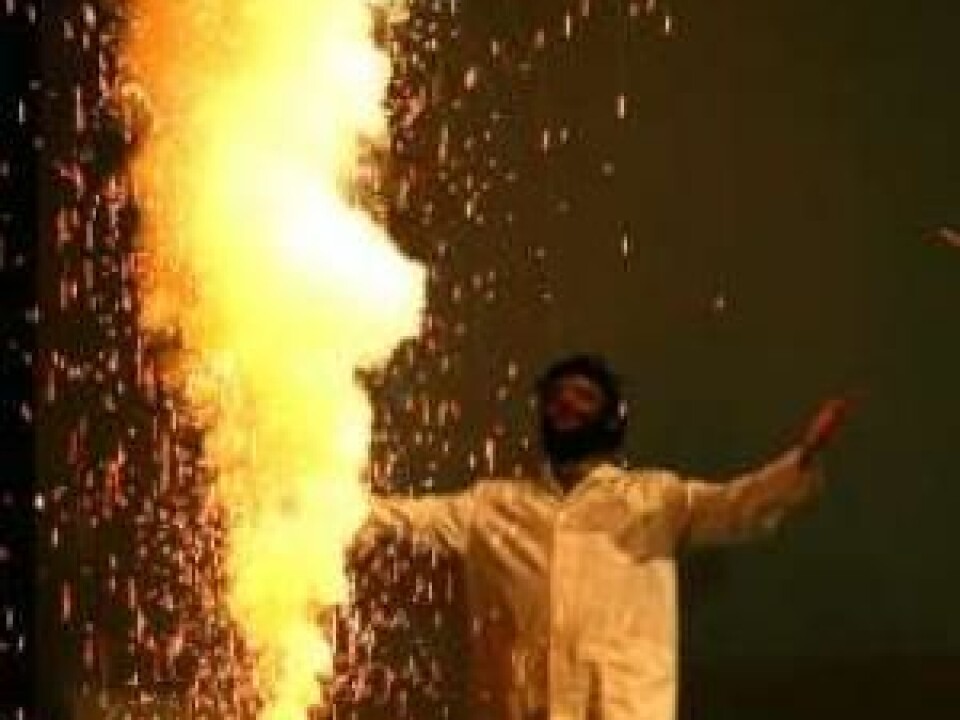
New Year’s rocket science
Here's the full story of what happens after you've lit the fuse of a rocket and run off to a safe distance.
Whoosh!
There's always a thrill in watching rockets shoot up into the night sky. But have you ever wondered what's packed inside a rocket, and how the whole thing works? ScienceNordic asked fireworks expert Kristoffer Bredahl of Copenhagen's Experimentarium to provide the answers.
Peas and cooking salt
The first thing Bredahl says about rockets comes as something of a surprise to most people: one of the key components inside a rocket are dried peas. These peas, which are coated with metal salts, are responsible for the starburst of colour in the night sky. So when a rocket has delivered its lightshow, it literally rains peas on the festive audience below.
But back to those metal salts. Bredahl explains that the chemical effect which produces the colours is something that many of us have seen in our kitchens at home.

"Have you ever noticed that when salted water boils over in a pan on a gas cooker, you see an intense yellow colour when the water contacts the flame? That is due to the cooking salt, or sodium chloride, in the water. If you used potassium chloride instead, you would see a violet colour. It is essentially the same effect that rockets use to produce vivid colours in the night sky."
While sodium and potassium salts produce yellow and violet, other metal salts produce other colours. Strontium salts give a red colour, barium salts a green colour, and copper salts a blue colour.
Rocket anatomy
The body of a rocket consists of four key components: the propellant, the delay charge, the explosive charge, and the lightshow.
The first of these is housed in the thick paper tube at the bottom of the rocket, and has a space through the centre, called the 'soul', which contains the ignition fuse.

The propellant is usually a finely blended mixture of sulphur, charcoal and saltpetre (potassium nitrate, KNO3). The first two ingredients combust while the latter supplies the oxygen. This means that the propellant burns without using atmospheric oxygen, in contrast to ordinary combustion where oxygen is necessary.
The propellant is so highly compressed that the combustion gases cannot penetrate it, and so combustion takes place only on the surface, explains Bredahl. The gases, principally carbon dioxide and steam, are rapidly pressurised and forced out of the end of the rocket at high speed, while an exit nozzle further augments the velocity. The downward force of the combustion gases exerts an equal upward force on the rocket, which then shoots up into the sky.
“It's a classic demonstration of Newton's Third Law of action and reaction,” he adds.
Sparkling charcoal
It is also the propellant mixture that provides the shower of sparks that trace the rocket's upward path, as Bredahl explains:
Rockets are a classic demonstration of Newton's Third Law of action and reaction
"The shower of sparks is created by blending extra charcoal into the mixture. When the charcoal particles burn, they produce the same red colour as the hot embers of a barbeque grill, and this is what produces the red sparks in the exhaust gases of the rocket."
When the rocket has used up its propellant, a further stage of combustion begins inside the rocket in the delay charge, which is often made of plain sugar. Compared with the propellant, this combusts more slowly, and thus reduces the upward velocity of the rocket.
The light show
As the delay charge burns down towards the explosive charge, the rocket coasts upwards to its maximum height. The explosive mixture is composed of finely ground metal powder and the powerful oxidising agent, potassium chlorate (KClO4).
At the top of the rocket's flight, the rapidly increasing internal temperature causes the mixture to explode, scattering the payload of glittering stars (which we now know are peas) in all directions. Besides the metal-salt coating, they have another ingredient to augment the light show, as Bredahl reveals:
"Having been soaked in the metal salt solution, the peas are dusted with gunpowder. They are laid out to dry in the sun and then poured into the nose cone at the top of the rocket. An extra sprinkling of gunpowder inside the nose cone works wonders," says the fireworks expert.
Translated by: Nigel Mander




